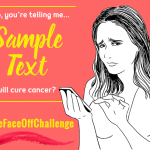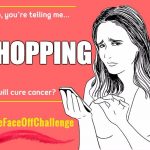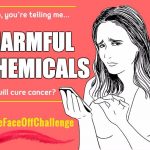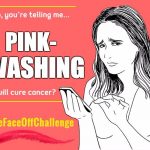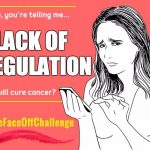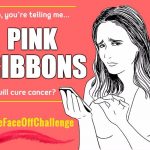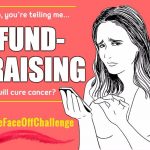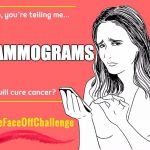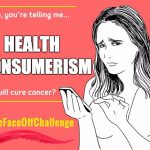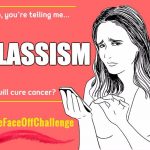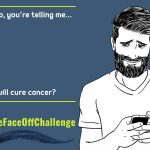Breast cancer as a health crisis is unavoidably gendered because the disease most often affects women. However, the cause has overcompensated for breast cancer’s threat to femininity as its treatment often causes loss of breast tissue, hair, and other symbols representing ideals of femininity. Further, an abundance of pink ribbon beauty products have become associated […]
SHOPPING?
The marketing of pink ribbon beauty products encourages women to apply a magnitude of products and seldom understood substances to their bodies for a good cause. Sixty percent of what you apply to your skin is absorbed directly into the bloodstream. Babies and children absorb 50-60% more than adults. #TheFaceOffChallenge is a social media campaign […]
HARMFUL CHEMICALS?
Some ingredients found in beauty and personal care products contain substances discovered as linked to health issues such as cancer. Health issues linked to toxic chemicals in the body include: skin allergies; learning disabilities; infertility; birth defects; reproductive problems; cancer; brain, liver, and kidney abnormalities; respiratory irritation; hormone disruption; and more. After you upload a […]
PINKWASHING?
Pinkwashing is a term describing when a company’s mission, practices, or products are incongruent with its engagement in cause-based marketing. For example, when a company markets a pink ribbon product, but its production or use threatens health, the organization is engaging in pinkwashing. Breast Cancer Action and Think Before You Pink are good resources highlighting pinkwasher companies […]
LACK OF REGULATION?
The last time the United States government updated cosmetics laws was in 1938. 1300+ ingredients in United States beauty products have been banned in other countries such as the European Union. Only 30 ingredients are prohibited or restricted by the United States Food and Drug Administration. After you upload a peach overlay to your profile […]
PINK RIBBONS?
A directed role of individual volunteer generating breast cancer awareness has been established over collective breast cancer activism. A directed volunteer carries out actions and directions determined by organizations, rather than voicing alternative opinions. No single perspective is wrong, but multiple perspectives and directions are needed to impact the breast cancer health crisis. Participating in […]
FUNDRAISING?
Volunteers are also positioned predominantly as fundraisers because currently money is the currency of power. Fundraising converts an individual’s philanthropic energy into a neutral entity that can be controlled and leveraged by conglomerates of power to approach breast cancer from their perspective. #TheFaceOffChallenge offers a cost-free and time sensitive way for people to make an […]
CELEBRATION?
Pink ribbon culture is celebratory with the pinnacle of celebration being breast cancer survivorship. This celebration serves as acknowledgement that the directed role of volunteer fundraiser is effective and worthwhile. Activism, on the other hand, doesn’t involve celebration; activism actively challenges perspectives and the status quo to incite change. Additionally, celebration is problematic because it […]
CORPORATIONS?
The breast cancer cause has been co-opted by corporations. From the establishment of Breast Cancer Awareness Month during the mid 1980s by a pharmaceutical company, to the myriad of companies that offer pink ribbon products and engage in cause-based marketing each year, a health crisis has been corporatized and your role is to serve as […]
DRUGS?
The funds generated by pink ribbon philanthropy at best are dedicated to research, at worst to organization administration and event costs or corporate profits. Cause-based marketing donations are often minimal when you read the fine print or worse you may discover pink ribbon products are produced by pinkwashers. Even funding research can be problematic when […]
MAMMOGRAMS?
Mammograms and early detection are a significantly worthwhile approach to breast cancer survivorship. Mammograms are aimed at diagnosing breast cancer in early stages, so it may be treated and removed from the body. However, it is important to understand that mammograms and early detection are a reactionary approach, which should be paired with proactive approaches […]
HEALTH CONSUMERISM?
Another way women are positioned as consumers in the breast cancer issue is as health consumers. Suggested mammograms, treatments, and pharmaceuticals, as well as physician visits are commodities, which women are encouraged to obtain regularly. Continue to seek medical attention, but attempt to think about the breast cancer health crisis beyond individual health consumerism. Participating […]
INDIVIDUALISM?
Pink ribbon culture involves two directed citizen roles: a collective role of volunteer fundraiser and an individual role aimed at early detection. A fear of breast cancer influences women to monitor their individual bodies for breast cancer. This approach may increase an individual woman’s chances for early detection and survivorship. However, it does little on […]
CLASSISM?
Because of the focus on consumerism and money as the currency of power in pink ribbon culture – citizens are directed into roles as a volunteer fundraiser, health consumer, and consumer of pink ribbon products – the breast cancer issue has become classed. Only the economically able and adequately insured can participate according to these […]
US POLITICS?
A recent trend during Breast Cancer Awareness Month is for cities across the globe to illuminate landmarks in pink. Pink landmarks such as the London Eye in England, the Eiffel Tower in France, the Taj Mahal Palace and Tower in India, even Tokyo Tower in Japan symbolize a seemingly innocent adoption of the United States […]
MEN?
On November 1st, the #TheFaceOffChallenge for breast cancer ends. Now, men are challenged to repurpose #TheFaceOffChallenge for men’s health awareness in November. Beginning November 1st, challenge the men in your life to grow mustaches and beards to display on social media profile pictures, add a color overlay, and consider whether men’s health messages follow a […]

